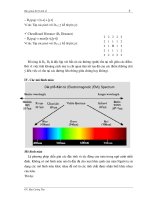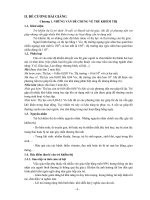Basic Geotechnical Earthquake Phần 2 ppsx
Bạn đang xem bản rút gọn của tài liệu. Xem và tải ngay bản đầy đủ của tài liệu tại đây (548.65 KB, 16 trang )
6 Basic Geotechnical Earthquake Engineering
India has resulted in flexure of Indian Plate (Bilham et al., 2003). The wavelength of flexure
is of the order of 650 km. It results in approximately 450-m-high bulge near the central
Indian Plateau. Normal faulting earthquakes occur north of this flexural bulge (e.g. possibly
on 15 July 1720 near Delhi) as well as deep reverse faulting also occurs beneath its crest (e.g.
the May 1997 Jabalpur earthquake). Furthermore, shallow reverse faulting also occurs south
of the flexural bulge where the Indian plate is depressed (e.g. the Sept. 1993 Latur earthquake,
Fig. 1.2).
The presence of flexural stresses as well as of plate-boundary slip permits all mechanisms
of earthquakes to occur beneath the Lesser Himalaya (Fig. 1.2). At depths of 4 – 18 km great
thrust earthquakes with shallow northerly dip occur infrequently. This permits the northward
descent of the Indian Plate beneath the subcontinent. Earthquakes in the Indian Plate
beneath these thrust events range from tensile just below the plate interface, to compressional
and strike-slip at depths of 30-50 km (e.g. the August 1988 Udaypur earthquake).
A belt of microearthquakes and moderate earthquakes beneath the Greater Himalaya
on the southern edge of Tibet indicates a transition from stick-slip fault to aseismic creep at
around 18 km. This belt of microseismicity defines a small circle which has a radius of 1695
km (Seeber and Gornitz, 1983).
1.3.2 Historic Data Sources and Catalogues
Early earthquakes described in mythical terms include extracts in the Mahabharata
during the Kurukshetra battle (Iyengar, 1994). There are several semi-religious texts mentioning
a probable Himalayan earthquake during the time of enlightment of Buddha c. 538 BC.
Archaeological excavations in Sindh and Gujarat suggest earthquake damage to now
abandoned Harrappan cities. A probable earthquake around 0 AD near the historically important
city of Dwarka is recorded, since zones of liquefaction in the archeological excavations of the
ancient city were found (Rajendran et al., 2003). The town of Debal (Dewal, Debil, Diul
Sind or Sindi) near the current site of Karachi was alleged to have been destroyed in 893 AD
(Oldham 1883). Rajendran and Rajendran (2002) present a case that the destruction of Debil
was caused by an earthquake linked to the same fault system responsible for the 1819 and
2001 Rann of Kachchh earthquakes. However, Ambraseys (2003) notes that the sources of
Oldham’s account probably refer to Daibul (Dvin) in Armenia, and that liquefaction 1100
years ago must be attributed to a different earthquake.
There was a massive earthquake in the Kathmandu Valley in 1255 (Wright, 1877). It
was a great earthquake because it was alleged to have been followed by three years of
aftershocks. However, the absence of reports from other locations renders this of little value
in estimating its rupture dimensions or magnitude. Similarly the arrival of Vasco de Gama’s
fleet in 1524 coincided with a violent sea-quake and tsunami that caused alarm at Dabul
(Bendick and Bilham, 1999). Note that this Portuguese port on the Malabar Coast is unrelated
to Debil above.
An important recent realization is that a sequence of significant earthquakes occurred
throughout the west Himalaya in the 16th century. The sequence started in Kashmir in 1501,
which was followed by two events a month apart in Afghanistan and in the central Himalaya.
Introduction to Geotechnical Earthquake Engineering 7
The sequence concluding with a large earthquake in Kashmir in 1555. The central Himalayan
earthquake may have been based on its probable rupture area. It destroyed monasteries
along a 500 km segment of southern Tibet, in addition to demolishing structures in Agra and
other towns in northern India.
A Himalayan earthquake that damaged the Kathmandu Valley in 1668 is mentioned
briefly in Nepalese histories. Earthquakes in the 18th century are poorly documented. An
earthquake near Delhi in 1720 caused damage and apparent liquefaction. However, little else
is known of this event (Kahn 1874; Oldham 1883). This event, from its location, appears
to be a normal faulting event. However, since there is absence of damage accounts from the
Himalaya it may have been a Himalayan earthquake as well. In 1713 a severe earthquake
damaged Bhutan and parts of Assam (Ambraseys and Jackson, 2003).
Thirteen years later, in September 1737, a catastrophic earthquake is alleged to have
occurred in Calcutta. This is the most devastating earthquake to be listed in many catalogues
of Indian as well as in global earthquakes. There was a storm surge that resulted in numerous
deaths by drowning along the northern coast of the Bay of Bengal. The hand-written ledgers
of the East India Company in Bengal detail storm and flood damage to shipping, warehouses
and dwellings in Calcutta (Bilham, 1994).
India in the early 19th century was as yet incompletely dominated by a British colonial
administration. An earthquake in India was something of a rarity. It generated detailed letters
from residents describing its effects. Few of the original letters have survived, but the earthquakes
in Kumaon in 1803, Nepal in 1833 and Afghanistan in 1842 were felt sufficiently widely to
lead scientifically inclined officials to take a special interest in the physics and geography of
earthquakes.
An army officer named Baird-Smith wrote a sequence of articles 1843-1844 in the
Asiatic Society of Bengal summarizing data from several Indian earthquakes and venturing
to offer explanations for their occurrence. He was writing shortly after the first Afghan war
which had coincided with a major 1842 earthquake in the Kunar Valley of NE Afghanistan
(Ambraseys and Bilham, 2003a). The director of the Geological Survey of India, Thomas
Oldham (1816-1878) published the first real catalog of significant Indian events in 1883.
His catalog includes earthquakes from 893 to 1869.
His son, Richard D. Oldham (1858-1936), wrote accounts of four major Indian earthquakes
(1819, 1869, 1881, and 1897). He completed first his father’s manuscript on the 1869
Silchar, Cachar, Assam earthquake which was published under his father’s name. He next
investigated the December 1881 earthquake in the Andaman Islands, visiting and mapping
the geology of some of the islands. His account of the 1897 Shillong Plateau earthquake in
Assam was exemplary, and according to Richter provided the best available scientific analyses
of available physical data on any earthquake at that time.
R.D. Oldham’s accounts established a template for the study of earthquakes that
occurred in India subsequently. The great earthquakes of 1905 Kangra and 1934 Bihar/
Nepal were each assigned to Geological Survey of India special volumes. However, these
never quite matched the insightful observations of Oldham’s 1899 volume. Investigations
of the yet larger Assam earthquake of 1950 were published as a compilation undertaken
8 Basic Geotechnical Earthquake Engineering
by separate investigators (e.g. Ray 1952 and Tandon, 1952). In many ways this proved
to be the least conclusive of the studies of the 5 largest Indian earthquakes during 1819-
1950.
Home Work Problems
1. Explain the concept of geotechnical earthquake engineering.
2. Enlist activities to be performed by geotechnical earthquake engineer.
3. Write short note on tectonic setting of India.
4. Using historic data sources explain about historic earthquakes in India.
9
EARTHQUAKES
2
CHAPTER
2.1 PLATE TECTONICS, THE CAUSE OF EARTHQUAKES
The plates consist of an outer layer of the Earth. This is called the lithosphere. It is
cool enough to behave as a more or less rigid shell. Occasionally the hot asthenosphere of
the Earth finds a weak place in the lithosphere to rise buoyantly as a plume, or hotspot. The
satellite image in Fig. 2.1 below shows the volcanic islands of the Galapagos hotspot.
Fig. 2.1 Volcanic islands (Courtesy: NASA)
The map in (Fig. 2.3) of Earth’s solid surface shows many of the features caused by
plate tectonics. The oceanic ridges are the asthenospheric spreading centers, creating new
oceanic crust. Subduction zones appear as deep oceanic trenches. Most of the continental
mountain belts occur where plates are pressing against one another.
Fig. 2.4 Plate tectonic environments (Courtesy: )
There are three main plate tectonic environments (Fig. 2.4): extensional, transform,
and compressional. Plate boundaries in different localities are subject to different inter-plate
stresses, producing these three types of earthquakes. Each type has its own special hazards.
Fig. 2.5 Juan de Fuca spreading ridge (Courtesy: )
12 Basic Geotechnical Earthquake Engineering
At spreading ridges, or similar extensional boundaries, earthquakes are shallow. They
are aligned strictly along the axis of spreading, and show an extensional mechanism. Earthquakes
in extensional environments tend to be smaller than magnitude 8 (magnitude of earthquake
has been discussed in detail later).
A close-up topographic picture (Fig. 2.5) of the Juan de Fuca spreading ridge, offshore
of the Pacific Northwest, shows the turned-up edges of the spreading center. As crust moves
away from the ridge it cools and sinks. The lateral offsets in the ridge are joined by the
transform faults.
A satellite view (Fig. 2.6) of the Sinai shows two arms of the Red Sea spreading ridge,
exposed on land.
Fig. 2.6 Two arms of red sea spreading ridge (Courtesy: NASA)
Extensional ridges exist elsewhere in the solar system, although they never attain the
globe-encircling extent the oceanic ridges have on Earth. This synthetic perspective of a large
volcano on Venus (Fig. 2.7) is looking up the large rift on its flank.
At transforms, earthquakes are shallow, running as deep as 25 km. The mechanisms
indicate strike-slip motion. Transforms tend to have earthquakes smaller than magnitude 8.5.
The San Andreas fault (Fig. 2.8) in California is a nearby example of a transform,
separating the Pacific from the North American plate. At transforms the plates mostly slide
past each other laterally, producing less sinking or lifing of the ground than extensional or
compressional environments. The white dots in Fig. 2.8 locate earthquakes along strands of
this fault system in the San Francisco Bay area.
Earthquakes 13
Fig. 2.7 Large volcano on Venus (Courtesy: NASA/JPL)
Fig. 2.8 The San Andreas fault in California (Courtesy: USGS)
14 Basic Geotechnical Earthquake Engineering
Fig. 2.9 (Courtesy: NASA, Topography from NOAA)
At compressional boundaries, earthquakes are found in several settings ranging from
the very near surface to several hundred kilometers depth, since the coldness of the subducting
plate permits brittle failure down to as much as 700 km. Compressional boundaries host
Earth’s largest quakes, with some events on subduction zones in Alaska and Chile having
exceeded magnitude 9.
This oblique orbital view of Fig. 2.9 looking east over Indonesia shows the clouded
tops of the chain of large volcanoes. The topography of Fig. 2.9 shows the Indian plate,
streaked by hotspot traces and healed transforms, subducting at the Javan Trench.
Sometimes continental sections of plates collide; both are too light for subduction to
occur. The satellite image (Fig. 2.10) below shows the bent and rippled rock layers of the
Zagros Mountains in southern Iran, where the Arabian plate is impacting the Iranian plate.
Nevada has a complex plate-tectonic environment, dominated by a combination of
extensional and transform motions. The Great Basin shares some features with the great
Tibetan and Anatolian plateaus. All three have large areas of high elevation, and show varying
amounts of rifting and extension distributed across the regions. This is unlike oceanic spreading
centers, where rifting is concentrated narrowly along the plate boundary. The numerous
north-south mountain ranges that dominate the landscape from Reno to Salt Lake City are
the consequence of substantial east-west extension, in which the total extension may be as
much as a factor of two over the past 20 million years.
Earthquakes 15
Fig. 2.10 The Zagros Mountains in southern Iran (Courtesy: NASA)
The extension seems to be most active at the eastern and western margins of the
region, i.e. the mountain fronts running near Salt Lake City and Reno. The western Great
Basin also has a significant component of shearing motion superimposed on this rifting. This
is part of the Pacific - North America plate motion. The total motion is about 5 cm/year. Of
this, about 4 cm/year takes place on the San Andreas fault system near the California coast,
and the remainder, about 1 cm/year, occurs east of the Sierra Nevada mountains, in a zone
geologists know as the Walker Lane.
As a result, Nevada hosts hundreds of active extensional faults, and several significant
transform fault zones as well. While not as actively or rapidly deforming as the plate boundary
in California, Nevada has earthquakes over much larger areas. While some regions in California,
such as the western Sierra Nevada, appear to be isolated from earthquake activity, earthquakes
have occurred everywhere in Nevada.
2.2 SEISMIC WAVES
When an earthquake occurs, different types of seismic waves are produced. The main
seismic wave types are Compressional (P), Shear (S), Rayleigh (R) and Love (L) waves. P
and S waves are often called body waves because they propagate outward in all directions
from a source (such as an earthquake) and travel through the interior of the Earth. Love and
Rayleigh waves are surface waves and propagate approximately parallel to the Earth’s surface.
Although surface wave motion penetrates to significant depth in the Earth, these types of
waves do not propagate directly through the Earth’s interior. Descriptions of wave characteristics
and particle motions for the four wave types are given in Table 2.1.
16 Basic Geotechnical Earthquake Engineering
Table 2.1: Seismic Waves (Courtesy: )
Wave Type Particle Typical Other
(and names) Motion Velocity Characteristics
P, Alternating compressions V
P
~ 5-7 km/s P motion travels fastest in
Compressional, (“pushes”) and dilations in typical Earth’s materials, so the P-wave is the
Primary, (“pulls”) crust; >~ 8 km/s first-arriving energy on a
Longitudinal which are directed in the in Earth’s mantle seismogram. Generally smaller
same direction as the wave and core; ~1.5 and higher frequency than
is propagating (along the km/s in water; the S and Surface-waves.
ray path); and therefore, ~0.3 km/s in air. P waves in a liquid or gas are
perpendicular to the pressure waves, including sound
wavefront. waves.
S, Alternating V
S
~ 3-4 km/s S-waves do not travel through
Shear, transverse motions in typical Earth’s fluids, so do not exist in
Secondary, (perpendicular to the crust; Earth’s outer core (inferred
Transverse direction of propagation, >~ 4.5 km/s in to be primarily liquid iron)
and the ray path); Earth’s mantle; or in air or water or molten
commonly approximately ~ 2.5-3.0 km/s in rock (magma). S waves
polarized such that particle (solid) inner core. travel slower than P waves
motion is in vertical or in a solid and, therefore,
horizontal planes. arrive after the P wave.
L, Transverse horizontal V
L
~ 2.0-4.4 km/s Love waves exist because of
Love, Surface motion, perpendicular to in the Earth the Earth’s surface. They are
waves, Long the direction of depending on largest at the surface and
waves propagation and generally frequency of decrease in amplitude with
parallel to the Earth’s the propagating depth. Love waves are dis-
surface. wave, and there- persive, that is the wave
fore the depth of velocity is dependent on
penetration of the frequency, generally with
waves. In general, low frequencies propagating
the Love waves at higher velocity. Depth of
travel slightly faster penetration of the Love
than the Rayleigh waves is also dependent on
waves. frequency, with lower
frequencies penetrating to
greater depth.
R, Motion is both in the V
R
~ 2.0-4.2 Rayleigh waves are also
Rayleigh, direction of propagation km/s in the dispersive and the amplitu-
Surface waves, and perpendicular Earth depending des generally decrease with
Long waves, (in a vertical plane), on frequency of depth in the Earth.
Ground roll and “phased” so the propagating Appearance and particle motion
Earthquakes 17
that the motion is wave, and are similar to water waves.
generally elliptical- therefore the Depth of
either prograde depth of penetration of the Rayleigh
or retrograde. penetration of waves is also dependent on
the waves. frequency, with lower
frequencies penetrating to
greater depth.
2.3 FAULTS
The outer part of the Earth is relatively cold. So when it is stressed it tends to break,
particularly if pushed quickly! These breaks, across which slip has occurred, are called faults.
The most obvious manifestations of active faulting are earthquakes. Since these tend to
happen along the boundaries between plates, this is where most of the active faulting occurs
today. However, faulting can occur in the middle of the plates too, particularly in the continents.
In general, faulting is restricted to the top 10-15 km of the Earth’s crust. Below this level
other things happen.
There is a wide range of faulting. Furthermore, faults themselves can form surprisingly
complex patterns. Different types of faults tend to form in different settings. It has been
found that the faults at active rifts are different from those along the edges of mountain
ranges. Consequently, understanding the types and patterns of ancient fault can help geologists
to predict and reconstruct the forms of ancient rifts and mountain ranges. The faulting
patterns can have enormous economic importance. Faults can control the movement of groundwater.
They can exert a strong influence on the distribution of mineralisation and the subsurface
accumulations of hydrocarbons. Furthermore, they can have a major influence on the shaping
of the landscape. When an earthquake occurs only a part of a fault is involved in the rupture.
That area is usually outlined by the distribution of aftershocks in the sequence.
Fig. 2.11 Hypocenter and epicenter of earthquake (Courtesy: )
18 Basic Geotechnical Earthquake Engineering
We call the “point” (or region) where an earthquake rupture initiates the hypocenter
or focus. The point on Earth’s surface directly above the hypocenter is called the epicenter
(refer Fig. 2.11). When we plot earthquake locations on a map, we usually center the symbol
representing an event at the epicenter.
Generally, the area of the fault that ruptures increases with magnitude. Some estimates
of rupture area are presented in the Table 2.2 below.
Table 2.2: Rupture area of certain earthquakes
(Courtesy: http:// eqseis.geosc.psu.edu)
Date Location Length (km) Depth (km) (Mw)
12/16/54 Dixie Peak, NV 42 14 6.94
06/28/66 Parkfield, CA 35 10 6.25
02/09/71 San Fernando Valley, CA 17 14 6.64
10/28/83 Borah Peak, ID 33 20 6.93
10/18/89 Loma Prieta, CA 40 16 6.92
06/28/92 Landers, CA 62 12 7.34
Although the exact area associated with a given size earthquake varies from place to
place and event to event, we can make predictions for “typical” earthquakes based on the
available observations (Refer Table 2.3 below). These numbers give a rough idea of the size
of structure that we are talking about when we discuss earthquakes.
Table 2.3: Fault dimensions and earthquakes (Courtesy: )
Magnitude Fault Dimensions (Length × Depth, in km)
4.0 1.2 × 1.2
5.0 3.3 × 3.3
6.0 10 × 10
6.5 16 × 16, 25 × 10
7.0 40 × 20, 50 × 15
7.5 140 × 15, 100 × 20, 72 × 30, 50 × 40, 45 × 45
8.0 300 × 20, 200 × 30, 150 × 40, 125 × 50
2.3.1 Fault Structure
Although the number of observations of deep fault structure is small, the available
exposed faults provide some information on the deep structure of a fault. A fault “zone”
consists of several smaller regions defined by the style and amount of deformation within
them.
Earthquakes 19
Fig. 2.12 Structure of an exposed section of a vertical strike-slip fault zone
(after Chester et al., Journal of Geophysical Research, 1993).
Fig. 2.12 shows structure of an exposed section of a vertical strike-slip fault zone. The
center of the fault is the most deformed and is where most of the offset or slip between the
surrounding rock occurs. The region can be quite small, about as wide as a pencil is long, and
it is identified by the finely ground rocks called cataclasite (we call the ground up material
found closer to the surface, gouge). From all the slipping and grinding, the gouge is composed
of very fine-grained material that resembles clay. Surrounding the central zone is a region
several meters across that contains abundant fractures. Outside that region is another that
contains distinguishable fractures, but much less dense than the preceding region. Last is the
competent “host” rock that marks the end of the fault zone.
2.3.2 Fault Classifications
Active, Inactive, and Reactivated Faults
Active faults are structure along which we expect displacement to occur. By definition,
since a shallow earthquake is a process that produces displacement across a fault. All shallow
earthquakes occur on active faults.
Inactive faults are structures that we can identify, but which do not have earthquakes.
As we can imagine, because of the complexity of earthquake activity, judging a fault to be
inactive can be tricky. However, often we can measure the last time substantial offset occurred
across a fault. If a fault has been inactive for millions of years, it’s certainly safe to call it
inactive. However, some faults only have large earthquakes once in thousands of years, and
we need to evaluate carefully their hazard potential.
Reactivated faults form when movement along formerly inactive faults can help to
alleviate strain within the crust or upper mantle. Deformation in the New Madrid seismic
zone in the central United States is a good example of fault reactivation.
Faulting Geometry
Faulting is a complex process and the variety of faults that exists is large. We will
consider a simplified but general fault classification based on the geometry of faulting, which
we describe by specifying three angular measurements: dip, strike, and slip.
20 Basic Geotechnical Earthquake Engineering
Fig. 2.13 Figure explaining about dip (Courtesy: )
In Earth, faults take on a range of orientations from vertical to horizontal. Dip is the
angle that describes the steepness of the fault surface. This angle is measured from Earth’s
surface, or a plane parallel to Earth’s surface. The dip of a horizontal fault is zero (usually
specified in degrees: 0°), and the dip of a vertical fault is 90°. We use some old mining terms
to label the rock “blocks” above and below a fault. If you were tunneling through a fault, the
material beneath the fault would be by your feet, the other material would be hanging above
your head. The material resting on the fault is called the hanging wall, the material beneath
the fault is called the footwall.
Fig. 2.14 Figure explaining about strike (Courtesy: )
The strike is an angle used to specify the orientation of the fault and measured clockwise
from north. For example, a strike of 0° or 180° indicates a fault that is oriented in a north-
Earthquakes 21
south direction, 90° or 270° indicates east-west oriented structure. To remove the ambiguity,
we always specify the strike such that when we “look” in the strike direction, the fault dips
to our right. Of course if the fault is perfectly vertical we have to describe the situation as
a special case. If a fault curves, the strike varies along the fault, but this seldom causes a
communication problem if we are careful to specify the location (such as latitude and longitude)
of the measurement.
Fig. 2.15 Figure explaining about slip (Courtesy: )
Dip and strike describe the orientation of the fault, we also have to describe the
direction of motion across the fault. That is, which way did one side of the fault move with
respect to the other. The parameter that describes this motion is called the slip. The slip has
two components, a “magnitude” which tells us how far the rocks moved, and a direction (it’s
a vector). We usually specify the magnitude and direction separately. The magnitude of slip
is simply how far the two sides of the fault moved relative to one another. It is a distance
usually a few centimeters for small earthquakes and meters for large events. The direction of
slip is measured on the fault surface, and like the strike and dip, it is specified as an angle.
Specifically the slip direction is the direction that the hanging wall moved relative to the
footwall. If the hanging wall moves to the right, the slip direction is 0°; if it moves up, the
slip angle is 90°, if it moves to the left, the slip angle is 180°, and if it moves down, the slip
angle is 270° or –90°.
Hanging wall movement determines the geometric classification of faulting. We distinguish
between “dip-slip” and “strike-slip” hanging-wall movements.
Dip-slip movement occurs when the hanging wall moved predominantly up or down
relative to the footwall. If the motion was down, the fault is called a normal fault, if the
movement was up, the fault is called a reverse fault. Downward movement is “normal”
because we normally would expect the hanging wall to slide downward along the foot wall
because of the pull of gravity. Moving the hanging wall up an inclined fault requires work to
overcome friction on the fault and the downward pull of gravity.
When the hanging wall moves horizontally, it’s a strike-slip earthquake. If the hanging
wall moves to the left, the earthquake is called right-lateral, if it moves to the right, it’s called

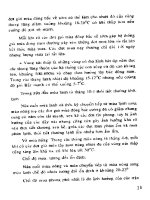

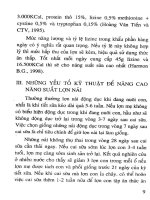
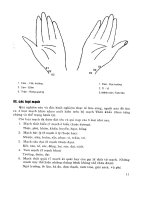
![[Nông Nghiệp] Kỹ Thuật Trồng Đậu Nành - Ks.Nguyễn Việt Thái phần 2 ppsx](https://media.store123doc.com/images/document/2014_07/13/medium_dlf1405268425.jpg)
